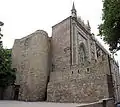Quadrangular Tower
Quadrangular tower (Azerbaijani: Dördbucaqlı qala) or Keep of the fortress of Baku (Azerbaijani: Bakı qalasının donjonu) is a historic tower of XIV century. The tower is also referred as a keep. It is a part of Old City and located on Kichik Gala street, in the city of Baku, in Azerbaijan. The building was also registered as a national architectural monument by the decision of the Cabinet of Ministers of the Republic of Azerbaijan dated August 2, 2001, No. 132.[1]
| Quadrangular tower | |
|---|---|
Azerbaijani: Dördbucaqlı qala | |
 | |
 Location within Azerbaijan | |
| Alternative names | Keep of the Fortress of Baku |
| General information | |
| Status | restored; operating as The Tower of Arts |
| Type | Keep |
| Architectural style | Architectural school of Shirvan-Absheron |
| Location | Old City |
| Address | Kichik Gala Street, 13 |
| Town or city | |
| Country | |
| Coordinates | 40.3679127°N 49.8342941°E |
| Completed | XIV century |
| Height | 16 m |
History
The tower was built in the 14th century.[2]
The towers were built as an integral part of the fortress wall while building defensive fortifications in Baku, to maintain the look, the strength of the fortress walls and to make the defense system even easier. According to writings of medieval authors, within 70 semicircular and northern fortress walls there was a quadrangular fortress-type tower. In the Middle Ages, either during the period of stability or in war, it was used as a weapon armory. The fortress-tower was built mainly for two purposes: controlling the area to further strengthen the northern part of Baku by forming a view of the fortress walls and to use the tower as a weapon storage.[3]
In 2014 substantial repair and restoration works were held on the tower by Old City State Historical-Architectural Reserve Department and after that it started to operate as Old City Traditional Art Center under the name of The Tower of Arts.
Architectural features
The height of the tower is 16 m, the thickness of the walls is 2 meters. For rapid movement of soldiers, an underground path, which continued along the bottom of the wall, was directed towards the tower gate. This underground path surrounded the city by the northern side.[2]
Gallery
- Different views of the tower




See also
References
- "Azərbaycan Respublikası ərazisində dövlət mühafizəsinə götürülmüş daşınmaz tarix və mədəniyyət abidələrinin əhəmiyyət dərəcələrinə görə bölgüsünün təsdiq edilməsi haqqında Azərbaycan Respublikasi Nazirlər Kabinetinin qərarı". e-qanun.az. Retrieved 15 March 2018.
- "Dördbucaqlı qala (XIV əsr)" (in Azerbaijani). icherisheher.az. Retrieved 15 March 2018.
- "Dördbucaqlı Qala" (in Azerbaijani). icherisheher.gov.az. Archived from the original on 19 January 2017. Retrieved 15 March 2018.
